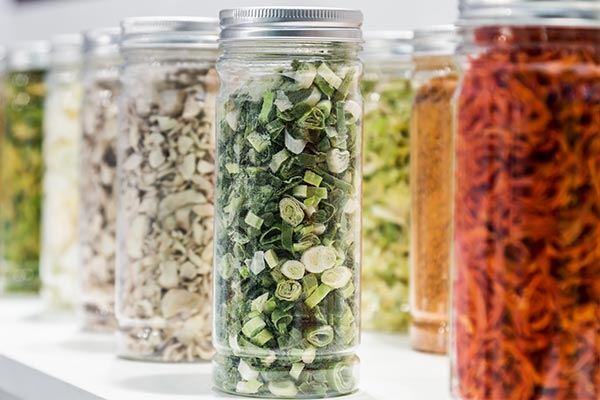
Tips for freeze-drying food at home
Freeze-drying machines are the more expensive option, with used machines being sold for at least $1,000. New freeze-drying machines can cost anywhere from $2,000 to $4,000. To save money, you can also opt to freeze-dry food at home using alternative methods. The home freezer method Freeze-drying food may seem overwhelming, but you can also do it with a home freezer. However, since you don't have a freeze-dryer this method will take longer. To freeze-dry food using your freezer, you will need the following items.- A cookie sheet, cooling rack, or large plate
- Food to be freeze-dried
- Storage space in the freezer
- Wash and cut up the food into small slices or chunks.
- Place the food on a tray in a single layer. Don't stack the sliced food.
- Place the tray in your freezer and keep it away from other food items.
- Freeze the food for two to three weeks. Check it periodically to make sure the food is being freeze-dried.
- Once done, remove the food and store it in an airtight container or bag.
- A large Styrofoam cooler
- Food to be freeze-dried, cut into slices or chunks
- Dry ice
- Freezer-safe, durable and airtight bags
- Wash and slice the food into small pieces or chunks. Store them in airtight, freezer-safe, but unsealed bags.
- Place the freezer bags in a large Styrofoam cooler.
- Cover the food with dry ice.
- Wait for at least 24 hours or longer.
- When the food is properly freeze-dried, remove the bags of dried food and store them properly.
Tips for dehydrating food at home
If you prefer a faster method, learn how to make dehydrated food. Knowing how to dehydrate food can also help prevent food waste since you can preserve items to be used later before they go bad. There are two ways to store dehydrated food for long-term storage: Using a canning jar sealer and using Mylar bags and oxygen absorbers. To dehydrate foods like fruits and vegetables, you will need a dehydrator and vacuum-sealed bags to store food. You can also store dehydrated food in clean canning jars, airtight food containers or freezer bags. Vegetables Vegetables must be dehydrated at 125 to 135 F for eight to 12 hours. Generally, when dehydrating food that you eat raw you don't need to pre-cook it before drying. However, vegetables like broccoli, celery and corn should be blanched before dehydrating. Blanching means cooking the food item in boiling water and submerging it in cold water. Blanching denatures enzymes that may affect the shelf-life and quality of the vegetables. To cut this step out, you can dehydrate frozen vegetables since they are already pre-cooked/blanched and ready to dehydrate. Fruit Fruit needs to be dried at 135 to 145 F for eight to 15 hours. Before dehydrating, some fruits like apples and bananas need to be treated with a citrus wash to delay browning. If you want to dehydrate other fruits, check food-specific recipes for the best results. After drying, the fruit's moisture content should be around 20 percent. Even if you're extra careful, the fruit will dry unevenly. Fruit also requires an extra step before storing. After the fruit cools completely, store it in plastic bags or glass jars for seven to 10 days. Shake the jars daily. Once done, store the fruit as is or ground it up into a powder. During this time, condensation should not develop. If it does, it means there is too much moisture in the fruit, so process it again in your dehydrator. Jerky Jerky should be dried at 160 F for four to eight hours. When processing meat to make jerky, follow recipes properly to avoid the risk of harmful bacteria. According to the United States Department of Agriculture (USDA) Jerky and Food Safety Fact Sheet, bacteria in meat can survive the temperatures of a dehydrator (150 to 160 F) when cooked at a warm temperature for a long time. To minimize the risk of food born illnesses from E. coli and salmonella, meat and chicken need to be pre-cooked at 160 F and 165 F, respectively, before dehydrating. Doing this helps destroy harmful bacteria that would survive under a dehydrator's temperature setting. Note that the shelf life of homemade jerky is one to two months. Meanwhile, store-bought jerky can last from eight months to one year. Here are different foods that you can dehydrate at home: Fruits:- Apples
- Bananas
- Apricots
- Cherries
- Grapes
- Mangos
- Peaches
- Beets
- Broccoli
- Cabbage
- Carrots
- Eggplant
- Mushrooms
- Zucchini
- Basil
- Dill
- Lavender
- Marjoram
- Mint
- Oregano
- Rosemary
- Sage
- Thyme
More related stories:
Food preservation 101: A step-by-step guide to air-drying fruits. Prepping skills: 15 Food storage and preservation methods to learn before SHTF. Freeze-drying is one of the best ways to preserve food for long-term storage. Sources include: AllNewsPipeline.com TheTrek.co Healthline.com Brighteon.comBrannon Howse shares tips on how Americans can SURVIVE a nuclear attack
By Kevin Hughes // Share
Adding milk to coffee can help fight inflammation, suggests study
By Zoey Sky // Share
SHTF survival: How to get home after an EMP attack
By Zoey Sky // Share
Two dozen states line up to sue Biden admin over pistol brace rule
By JD Heyes // Share
New research highlights top foods that may harm your brain and increase risk of cognitive decline
By patricklewis // Share
Former aide claims Netanyahu's first post-Oct. 7 priority was evading responsibility
By isabelle // Share
Mobility SOS: Decoding joint pain after 50 and the path to preservation
By willowt // Share
Kristi Noem declares endgame for Maduro as military pressure mounts
By jacobthomas // Share
Experts warn: Self-aware AI is a near-future desktop technology
By jacobthomas // Share
Microplastics invade reproductive organs—nature's colorful defense may be our best hope
By patricklewis // Share











